PS/SPS User Meeting
PS-SPS Users Meeting for Week 41 held on October 12th, 2023
The agenda for this meeting is based upon user schedule 2.1.1, please cf. here. Please note the current injector schedule which contains information about MDs, Technical stops, etc. and can be found here.
Next user meeting:
For week 42 on Thursday October 19th, 2023 10:30 CEST
Meeting room: 874/1-011 (CERN)
Previous EATM meeting from September 26th 2023:
indico.cern.ch/event/1329739/
News from the PS & SPS Physics Coordinator (E.B. Holzer, M. Jaekel)
News from the Facilities Operations Meeting (FOM) (M.Jäkel)
Check the Page 1 on the machine vistars for most up-to-date information of the beam availability:
https://op-webtools.web.cern.ch/vistar/vistars.php?usr=SPS1
https://op-webtools.web.cern.ch/vistar/vistars.php?usr=CPS
Now, during the LHC ion commissioning period more last-minute changes can happen than usually during the run.
During the rest of the run: Dedicated LHC filling with ions trains in the SPS. The fillings might last around 1 hour and repeat about every 5 hours.
- PS EA duty cycle is much reduced during the LHC filling periods --> If you require more cycles to finish your measurements - you can ask for some compensation during the other periods --> to be discussed at the user meeting.
- SPS NA --> no beam during dedicated LHC filling
- Pb source refill most likely on October 12th - about 10 hours without ion beams, plus some ramping up and optimisation required
Injector Schedule
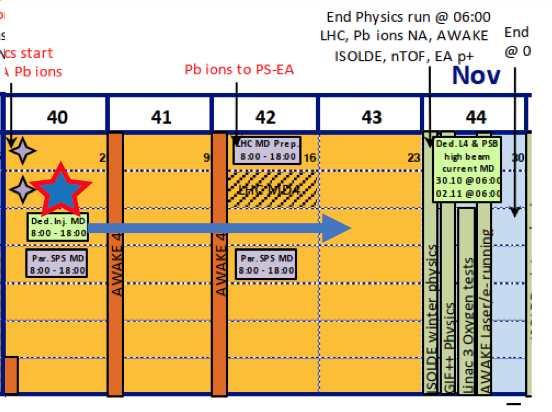
Preview of MDs:
Please note that during this periode the MDs migth change on short notice if problems occure in the SPS/LHC.
Wk 41 : No long parallel MD.
Refill of oven in the source (12.10 at 06:00). Beam to beam: ~12h.
No beam to NA.
Friday morning, ~30m without beam for source tune up after oven refill.
Wk 42 : Long parallel MDs (8h-20h) scheduled for Monday.
Dedicated MD (8-18h) moved to Wednesday week 43.
Dedicated Linac4 and PSB high intensity in week 44
Intensity split and wobbling
- Sharing between T2 and T4 (ion run)
- T2: 220E8 (was 160E8 in 2022)
- T4: 225E8
- Supercycle (2022, ions & AWAKE in parallel):
- SFTION1 -> AWAKE -> AWAKE -> AWAKE -> MD1.
- SC length: 50.4 s
- 2023 while dedicated NA ions (57.6 sec, 48BP)
- SFTION1 -> MD1 -> SFTION1 -> MD1
PS Machine Report (Bettina Mikulec)
- Availability for SPS 89.1%, for other destinations 93.3%
- Good week with few PS faults, but several injector faults (e.g. Linac3 cavity problem last Friday.
- No proton beam yesterday morning for 1h15m for regular PSB water leak inspection (in parallel to EAST and n_TOF access). Ion beams delivered in the meantime.
- POPS in degraded mode to fill up water of DCDC1 converter (known water leak) on Monday; after intervention a few POPS trips due to more stringent limits (peak power from 3.2 MW reduced to 2.5 MW); this morning the team swapped to work on DC3 (found another water leak)
- Issue with automatic asymmetry correction for EAST_T9 and EAST_N after introduction of averaging; solved Tuesday evening
- During last night, an issue with the proton injection kicker KFA45 stopped all proton beams for 4h40m; in parallel, another Linac3 cavity issue.
- Increase of EAST_T8 spill intensity from 60e10 p to 80e10 p approved from Thursday morning and rate limits for different EAST destinations clarified by RP, which allows increasing the overall flux to EAST
SPS Machine Report (Arthur Spierer)
- Availability from Thu to Thu: Overall 87.9%, NA: 89%, AWAKE: 99%
- 1h beam stop for RF on Monday & injectors faults
- NA
- Ion source refill on Thursday 12 from 6h to 18h
- AWAKE
- LHC: New shorter 10 inj. cycle will be tested operationally starting from Thursday 12
- No MDs this week
- Next week
- MDs
- Move Long parallel (ion) MD from Thursday to Monday
- Extend the slot by 2h → 8h-20h00 instead of 8h00-18h00
- LHC
- AWAKE
- MDs
Safety (J. Devine)
- ISIEC submissions have all been received in good time over the last week - thank you!
- Some users have reported issues with our website for the ISIECs, please make sure you are logged in to Drupal, even if you are already logged in you may need to do it again.
- Issue with lighting persists, especially the EHN1 Saleve side stair lighting. It has already been raised with EN/EL, will chase them again.
nToF (M. Bacak)
Physics programme progressing smoothly with one incident:
- EAR1: setups stable and taking data for transmission measurement with gaseous transmission sample/target.
- EAR2: implosion of small vacuum chamber window (25 um of Kapton, ~30 liter). Unfortunately detector pulverized and 26Al sample from a physics point-of-view destroyed. No release of contamination outside of the chamber - RP and safety following up. Change to in beam SiC and Si detector tests.
- NEAR: flux measurement with diamond continues, swap to off-beam measurements/dosimetry Tu-Th, then back with diamond.
Average proton flux is excellent. The mini-TOF (10e10) is highly appreciated by the NEAR experiments. We will need it for 1 week now and potentially after the 19th again.
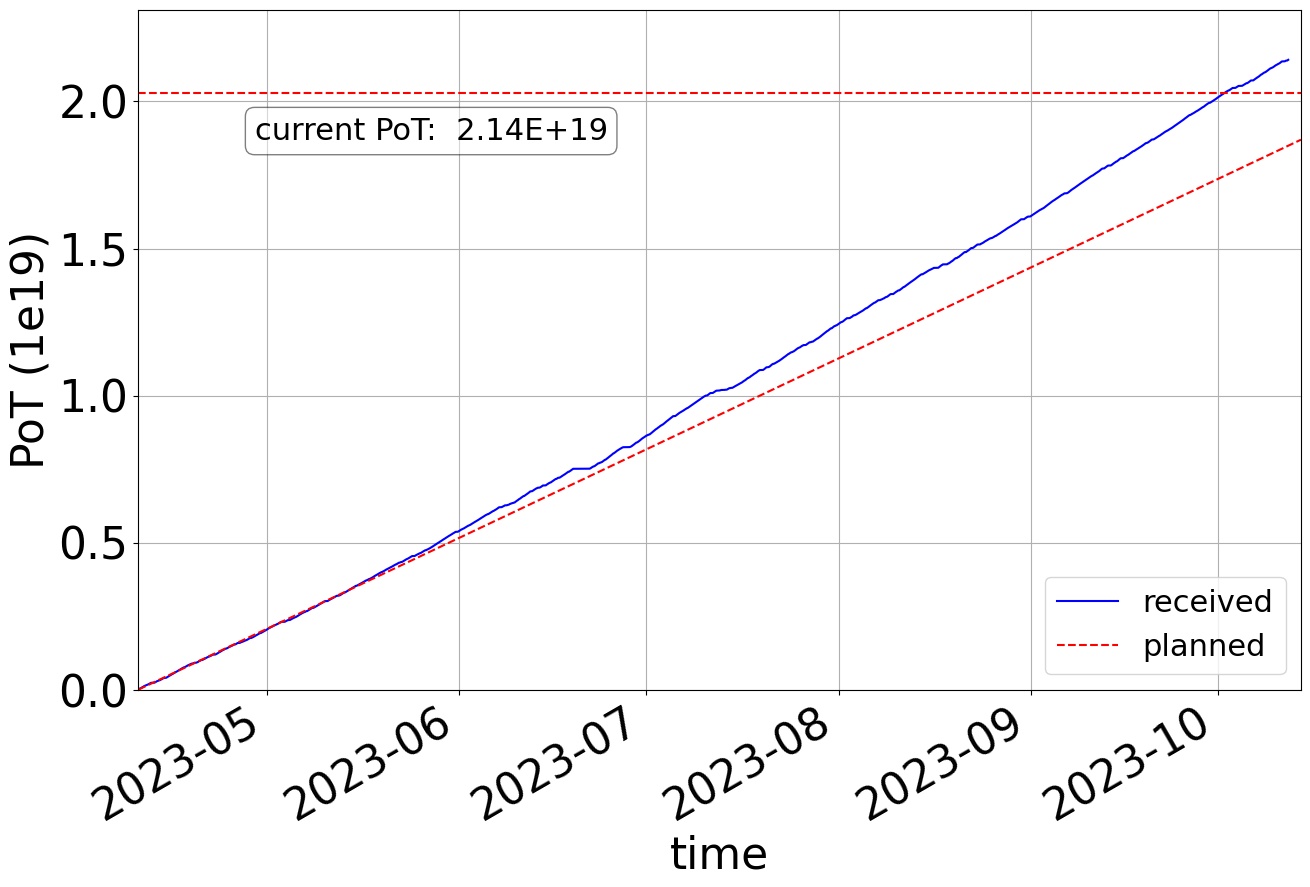
East Area Beam Status (D. Banerjee)
T9: Beam tuned for 3 GeV/c and 15 GeV, 10 GeV, 5 GeV hadrons for ALICE. Good operation.
T10: No issues.
T11: No issues.
East Area Users Tour de Table
T8 Main: IRRAD / CHARM (F. Ravotti / S. Fiore)
Very good week. On Monday (9th) afternoon during ion MD to the EAST DUMP wrong settings were loaded for the F61 QUADS (EAST3 user): this degraded the T8 beam for some hours (~14h30-20h00). Weekly intensity level above the target value (~2.3e16 p/w, see plot below) thanks to the high-intensity EAST_T8 (80E10 pps) run since last Thursday. Beam alignment and center on both X- and Y-axis less good than previous week (e.g. number of spills centered within +/- 2mm): ~93-94%.
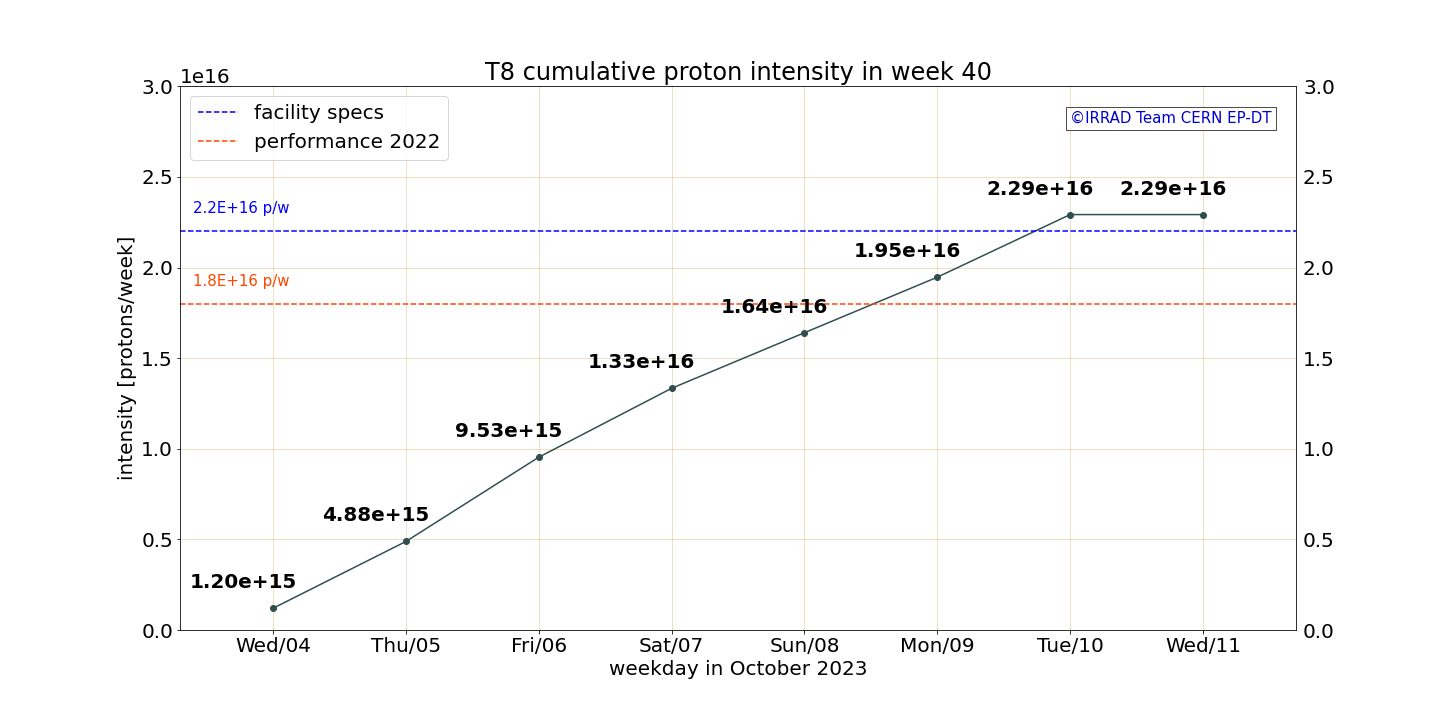
During the access on Wednesday, in IRRAD we exchanged the dosimetry, stop the cryostat and long-term experiments in Zone 3. Restarted CMS Pixel & passive samples for several users for the last steps. In CHARM, the TE/MPE (QPS) and TE/EPC (power converter) setups continue for a second week. We installed a RADNEXT users and test the degraders setup on the Montrac to be used during the CHIMERA ion run.
We run until the end of the proton run and switch to ions next Tuesday 17th in the morning.
T8 Incoming Main: CHIMERA - Week 42 (see above)
The setup of the ion beam will start on Tuesday 17th morning, once the proton run completed and all material removed from the beamline.
Wednesday 18th there will be the need also to access EA1 (in the morning in the shadow of the EA2 access) to install a measurement device on the last T8 beam-stopper. Two other short access slots in EA1 (~40min ventilation time included) during the afternoon will be also required.
T9 Outgoing Main: OREO (S. Carsi)
- Our beam time started on Wednesday 3th
- with a problem of the secondary beam, being out of target by centimeters. This problem was understood and solved in a couple of hours.
- The super cycle was quite overcrowded and we got more or less 2 spills out of 48.
- This beam test was a total success for us: we manage to perform all of the measurements we planned and the quality of the data collected is very good.
- Very big thanks to Dipanwita, Aboubakr, the CCC and all the CERN staff for helping us whenever we need
T9 Main: ALICE FOCAL (Ganesh Tambave)
We could take some 3 GeV electron data with Cherenkov.
In the following plots are shown with beam on (left) and beam off (right). The beam hit map on Si pad array (72 pads) detector of 325 micron thick is clearly visible. The MIP peak is also visible.
Please refer the plot.
T9 Incoming Main: SHiP-SBT - Week 42 (Annika Hollnagel)
Preparations for SHiP-SBT TB exposure with large 4-cell prototype detector going smoothly:
Holding structure (pre-assembled & tested in Freiburg) successfully arrived at Meyrin TB area. Liquid Scintillator IBC container currently in transit to CERN Prevessin. Other materials to be brought in person early next week.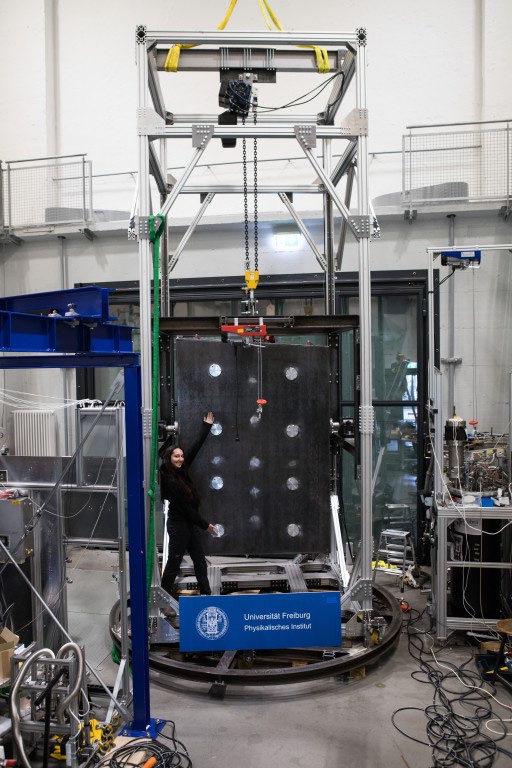
TB measurements planned mostly with muons, plus repeat measurement (w.r.t. 2022 DESY TB exposure) using electrons.
Setup planned to stay inside PS T9 until start of beam 2024 to be the first TB user for a repeat measurement of ‘aged’ detector, taking data with cosmics in the meantime.
T10 Main: ALICE RICH (Nicola Mazziotta)
Data taking progressing smoothly. During the week the beam was down for a while probably due to problem with the steering: it was promptly fixed.
Sometimes the BHZ027 is down and we need to put it first off (standby), then on and set the current.
Yesterday morning we were in free mode to fix some noise channels in our detectors. Here you can see the T10 beam at -10GeV/c as seen by our fiber tracker upstream (X0-Y0) and downstream (X1-Y1) modules. There are a couple of dead channels so we offset the module a little bit (the position is centered in the middle of the module).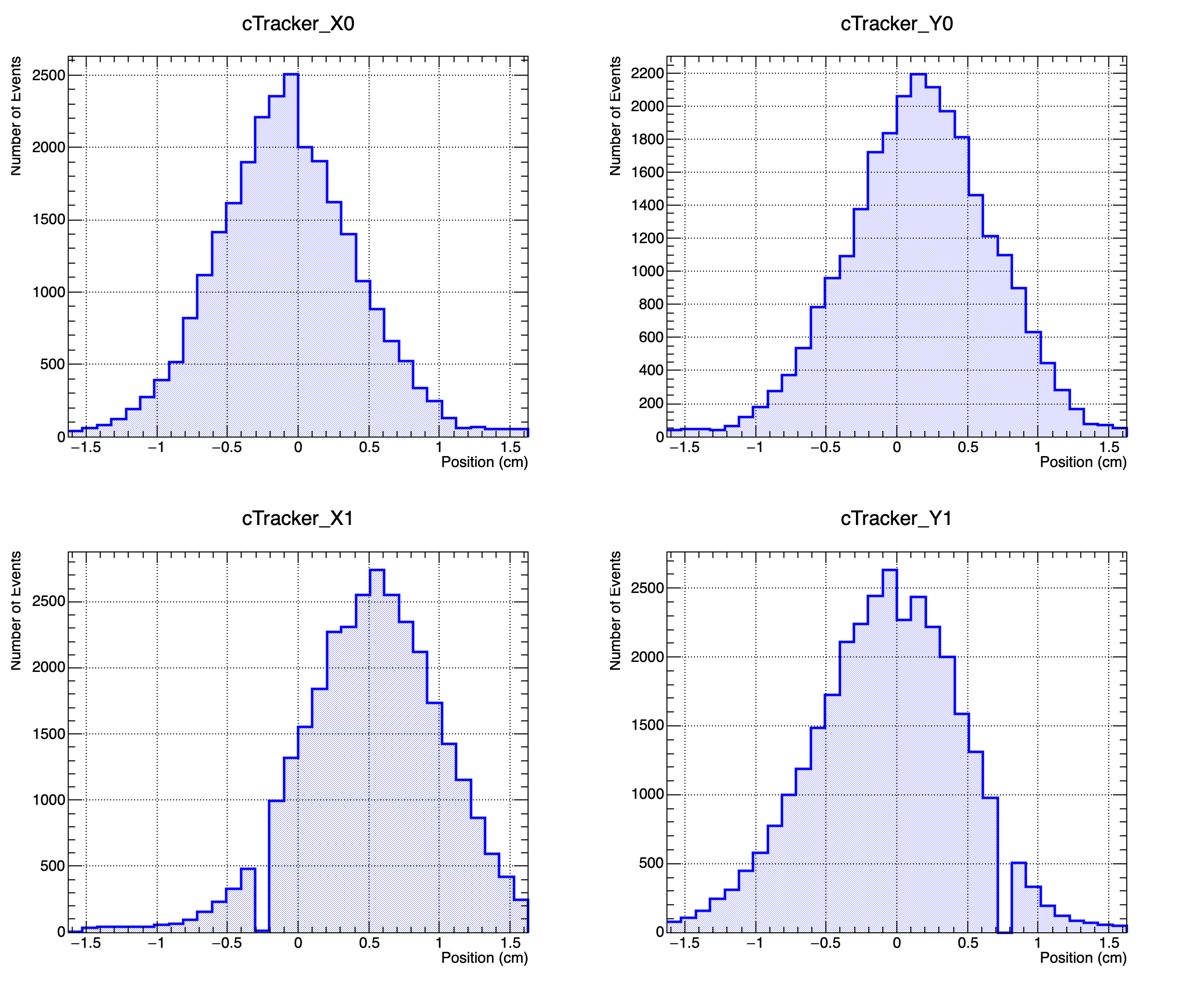
T10 Incoming Main: ALICE TIMING - Week 42 (Manuel Colocci)
Main: ALICE Timing (Manuel Colocci)
- CMOS, LGADs and SiPM sensors will be tested
- +10 GeV hadron beams (quite intense) needed
- XCSA3 table needed
- Satefy inspection booked for Wed 14.30
- Setup will be dismounted on Wed 25th
Parasitic: ALICE TOF (Despina Hatzifotiadou)
We will be testing small MRPCs (Multigap Resistive Plate Chambers) for fast timing.
We will move our stuff inside T10 on Wednesday 18 October.
We have arranged for safety inspection in the afternoon of that day.
We are in communication with the relevant people concerning the installation of a DESY table.
We have requested gas.
T11 Main: CLOUD (Eva Sommer)
CLOUD run is ongoing. Some minor gas system issues in the past week, but now continuing normally. Overall, all is well so far.
AWAKE (Giovanni Zevi Della Porta)
Monday-Saturday:
- Completed installation of mu-metal around plasma cell
- Laser contractor solved the pre-pulse issue and improved UV intensity on photocathode
- Mounted 10 new cameras for plasma light
- Patrolled area
Sunday: stated new proton run
- Begin with access for Rb density measurements
- Stable proton beam (no LHC): 1509 bunches in 7.2 hours
- Set up diagnostics and DAQ
- Determine settings and scan timing for 10 new cameras
- Commission electron beam with improved UV intensity
Plans
- Study proton-driven plasma light (a proxy for plasma wakefields) as a function of density step
- Study electron-driven plasma light in preparation for acceleration experiments
- AWAKE-only supercycle on Thursday (ongoing) while ions source is refilled
North Area Beam Status
Beamlines H2, H4, H6, H8 (D. Banerjee)
H2: Good operation.
H4: Good operation.
H6: No operation.
H8: Good operation, completed steering and focusing exercise with NA60+ for minimal beam spot size.
North Area Users Tour de Table
H2
H2 Main: NA61 SHINE (Piotr Podlaski)
- steady data taking through the week when ghe beam was available
- Some minor interventions planned duyring today’s break in the beam
- we are happy with quality of the beam and extraction: very fast feedback from the operators
- No deterioration of the beam quality observed during shared SFT/LHC cycles
- the only complaint are fluctuations of the intensity:
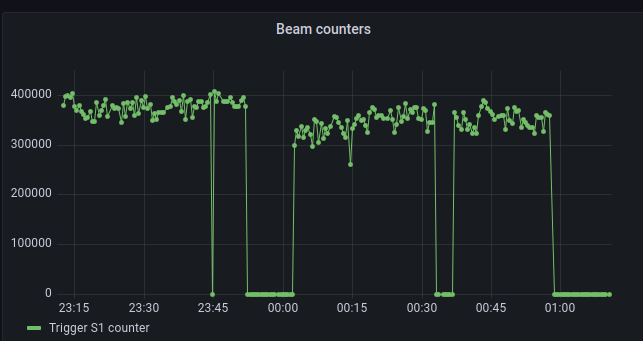
H4
H4 Outgoing Main: PAN (Daniil Sukhonos, UNIGE)
We have taken the data with Mini.PAN spectrometer at various angles with respect to the beam axis (-8 … +8∘
). The data was taken synchronously with all subdetectors of Mini.PAN: ToF scintillators, strip detectors and Timepix3 quads.
During the data taking a few issuses related to one of StripY boards were observed, but the rest of the subsytems worked perfectly fine.
We plan to finish the maintenance of Mini.PAN this week (StripY board replacement, power cable and connector reparations, firmware upgrades) and join Medipix as a parasitic user next week.
We would like to use a DESY table with the plate during our parasitic run instead of the Goliath table if possible.
On behalf of PAN collaboration I would like to thank SPS coordinators, beam physicists and technical crew for extensive help during our beam time as a main user!
H4 Main: RE44 HERD (Davide Serini)
We did no change the HERD main setup w.r.t. previous week. We use the Nikos conf file of 330 GeV/Z beam.
Experimental setup
Our goal is to study the response of the HERD subdetectors to high Z particles and measure charge resolution. We see a large halo mainly composed of low Z particles (Z<6), and we are still investigating.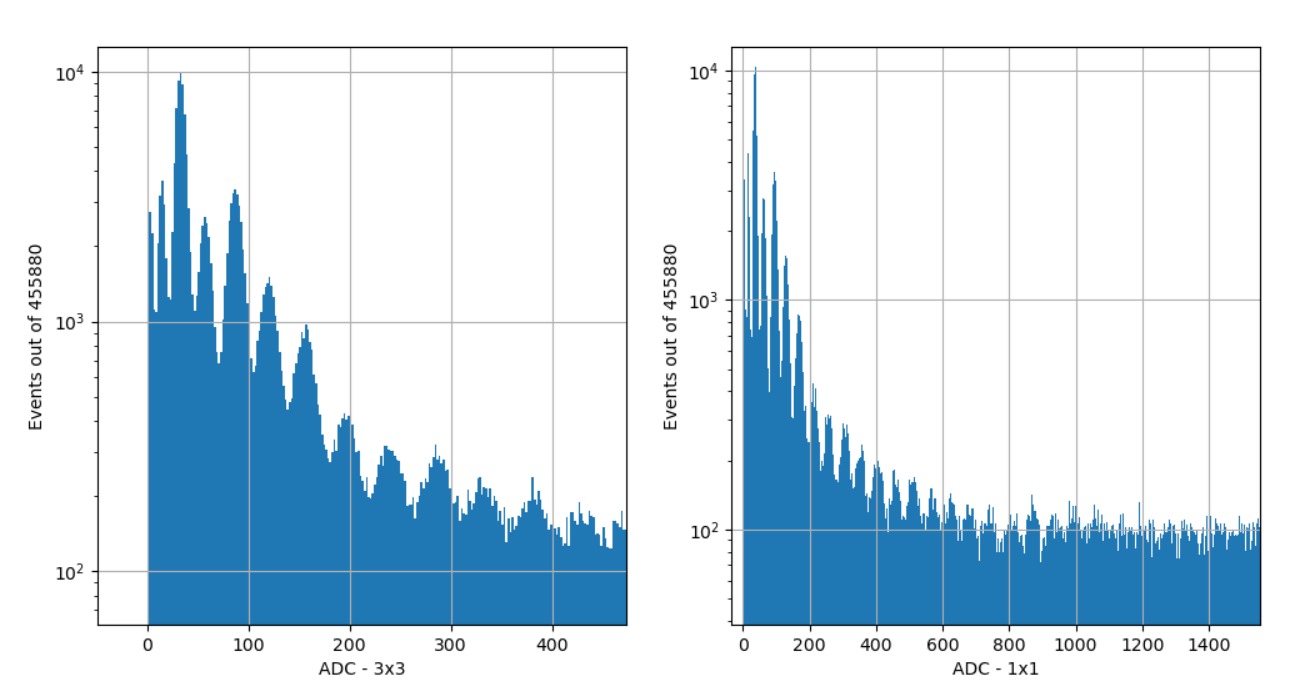
Beam composition detected by a scintillator tile (trigger threshold of about Z=2.5).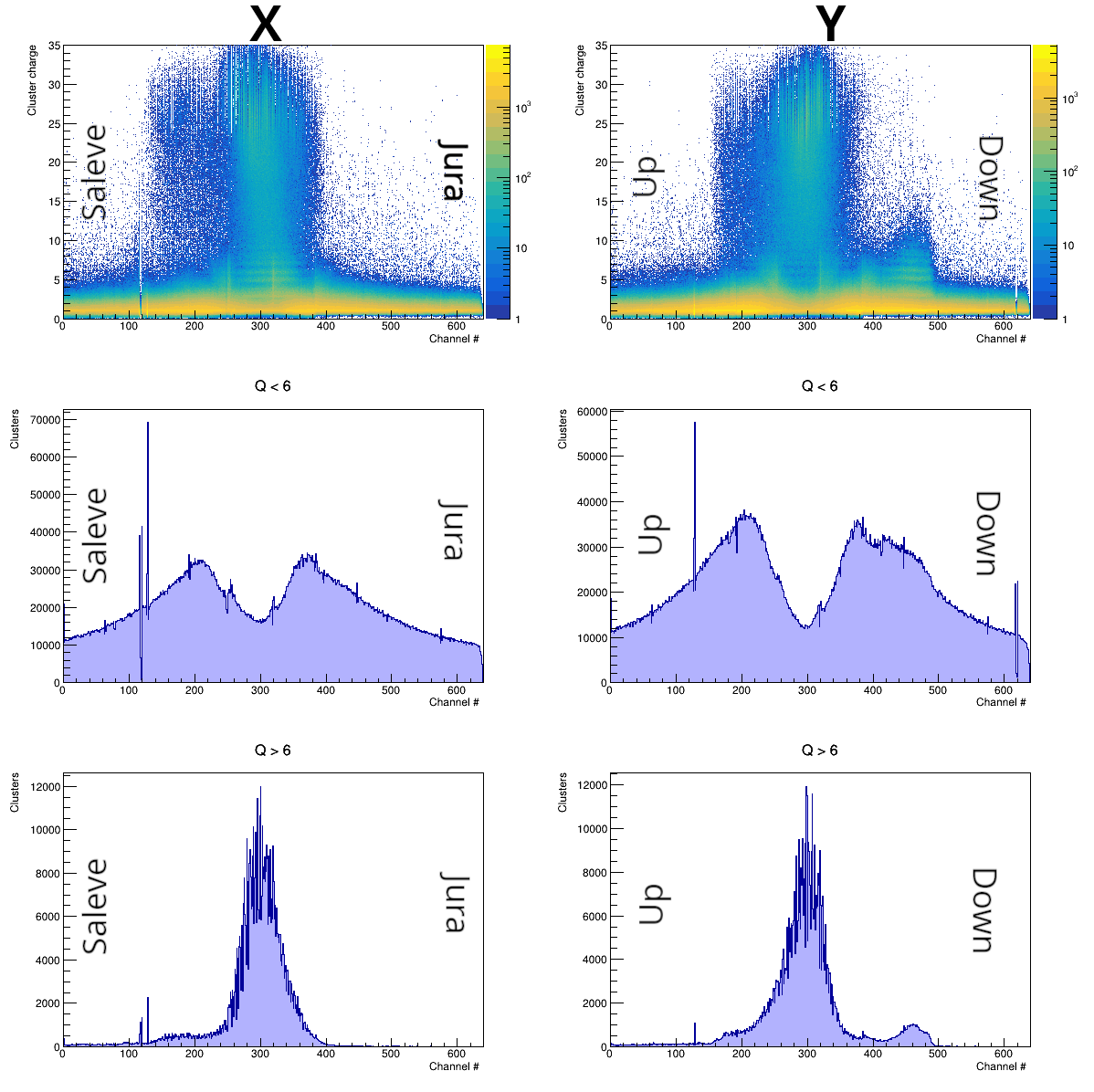
Beam profile from SCD detector
Row 1: Beam profile vs cluster charge in silicon microstrip detectors
Row 2: Beam profile in silicon microstrip detectors for low ions (mostly protons)
Row 3: Beam profile in silicon microstrip detectors for heavier ions
H4 Incoming Main: MEDIPIX - Week 42 (Benedikt Bergmann, Petr Burian, IEAP CTU)
The main contact person next week: Petr Burian (petr.burian@cern.ch)
- We plan installation on Monday, Oct. 16, 2023. Estimated time for installationa and alignment: 4 h. Safety inspection planned for Monday, 4 pm.
- We would need a movable table, DESY or XSCA table. Another standard table next to the beam would be nice for electronics.
We will test thin semiconductor boards (Timepix2,3) with sensors made of silicon and SiC. The goal is to study the energy measurement at high input charge. The total thickness of material in the beam is <~ 5 mm. Moreover, we will test software for real-time measurement.
We would like to measure 1-2 d with primary Pb ions, then fragments.
Parameters:
- Energy ~330 GeV/c
- 300k/spill
- spot size: >3 cm x >3 cm to cover the entire sensors.
However, we do not have strict requirement on beam parameters. We will adapt and discuss needs with PAN (Daniil).
H8
H8 Outgoing Main: VLAST (LI Xiang)
The VLAST has taken a lot of runs using Ion beams in H8, measuring ions up to Pb with various A/Z = 2.0 - 2.54.
We tested different ions with different intensities and different incident angles, getting clear measurement of the whole charge range of ions up to Pb.
The detector and platform have been moved to 887-R-M84, waiting for shifting to storage room.
Detailed data analysis is still going on for more precise results and better understanding of our detectors.
Many thanks to Michael Lazzaroni and Maarten Van Dijk for arrangement and making the beam files.
H8 Main: NA60+ (Roberta Arnaldi)
Setup consisting of two DESY tables (one with ALPIDE pixels+target and one with MWPC, GEM and uRwell) has been installed
Beam optics studies have been carried on successfully (rather narrow Pb beam spot at 150 GeV)
Detectors performances are under study. Results obtained so far are good
Charged multiplicity studies have started
Higher intensity Pb beam test expected on Friday
H8 Incoming Main: R2E - Week 42 (Please Add Your Name Here)
Parasitic Users
H4 Outgoing: RE44 HERD (Please Add Your Name Here)
T10: EIC DRICH (Please Add Your Name Here)
H8: STRAW TRACKER RD (Please Add Your Name Here)
T10 Incoming: ALICE TOF - Week 42 (Please Add Your Name Here)
AoB
Minutes by the respective speakers, edited by E. B. Holzer, M. Jaekel, and M. Schwinzerl
